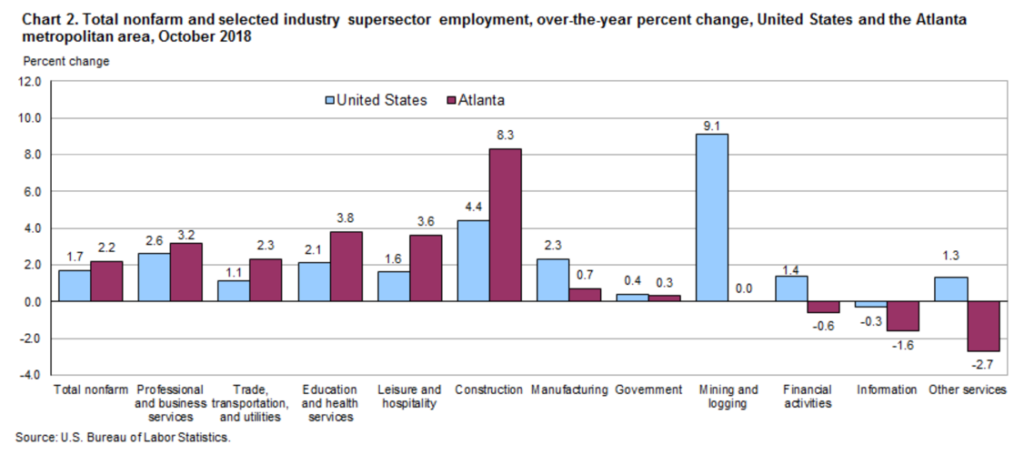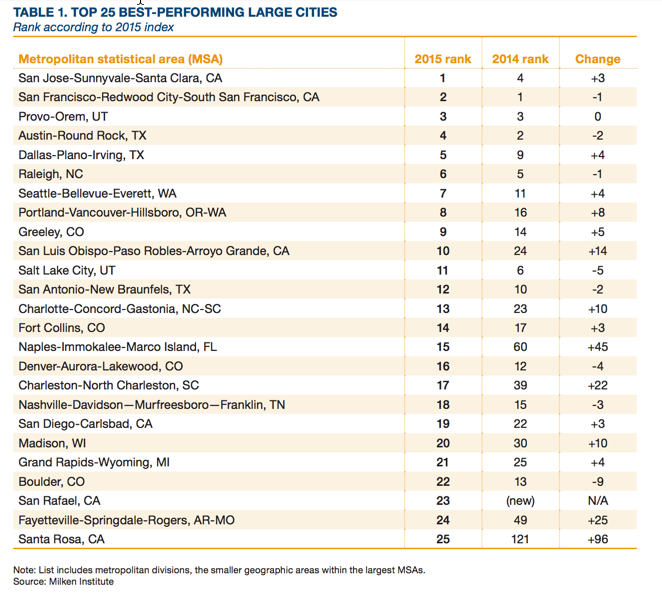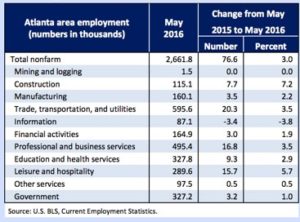Note: this post is from 2016, but it gets so much traffic we keep it up even tho some of the figure are stale. Please feel free to update the perspective with more recent numbers if you find the general theme compelling. I updated the jobs figures to 2018, for example, to see if the loss of tech/IT jobs was a continuing trend–it is. The venture numbers have also changed in scale, but not meaningfully in scope and direction. – lc
___________________
Did you see the recent report by CBRE that Atlanta is the #10 city in the US for tech talent? It’s just one more accolade on a growing list of things Atlanta can be proud of, like:
- The Atlanta return on venture capital invested in startups (MOIC) is among the Top 10 in the country. (I love this one).
- With 17 of the global Fortune 500 headquarters, we rank in the top 10 cities for Fortune 500 headquarters.
- We rank 5th in university research, with over $1B invested annually.
- Our investor angels rank 4th in the country for performance.
- ATL is the largest incubator hub in 900 miles, with 500,000+ square feet of office space dedicated to innovation.
- World class programs support startups specifically, like TechStars, Flashpoint, ATDC, the Microsoft Innovation Center, and AT&T Foundry.
Why we should care about tech jobs for our Top 10 Tech Talent
Today, only 62.7 percent of adult Americans work. For those who do, real wages haven’t increased in 20 years. Except, in technology–a bright spot for Atlanta and other top tech jobs cities. The average US developer salary is $100K (BLS 2016).
Tech economy jobs are easy to retrofit
- Average time to retrain for an entry level tech job? Just 12 months
- Number of current working developers who are self taught: 48%
- Cost of basic coder education: substantially free on sites like Codecademy
- Number of current developers with zero computer science college education? 30% (That’s right, it’s great to have Georgia Tech here, but most working developers earning those 100K salaries don’t have that kind of education.)
(Good stuff, right? See links to facts here.)
How Atlanta drives tech jobs
This recent AJC article about our Atlanta tech jobs economy being dependent on outdated business models like landline communication is concerning. What we want here are tech jobs that are organic and sustainable. It’s smart to entice jobs our way with tax subsidies. It’s also strong that we have an aggressive stance on importing corporate headquarters whenever we can. Our economic development teams devoted to that at city, state and private levels like the chambers of commerce are doing heroic work.
To get more well-heeled boots on the Beltline, though, we need more early stage capital. It’s an element we don’t think much about, but we should–and it’s one of the reasons I started Valor Ventures. Today, our tech job growth is a bit stale–it’s negative 3%. See the latest BLS figures:

Quoting BLS “Since October 2017, three industry supersectors in the Atlanta area lost over 1,000 jobs: other services (-2,700), information (-1,600), and financial activities (-1,100). Over the year, U.S. employment was up in other services (+1.3 percent) and financial activities (1.4 percent); while down in information (-0.3 percent).”
So if Atlanta has amazing tech job talent, where’s the tech job growth?
The Milliken Report does an independent annual study of the top cities for tech job growth. Here it is:
 We just didn’t make the list. The top cities for tech job growth have a secret weapon, and it’s early stage venture capital. Here’s what the report said about what’s fueling the top city, and by implication, all the top 10 cities.
We just didn’t make the list. The top cities for tech job growth have a secret weapon, and it’s early stage venture capital. Here’s what the report said about what’s fueling the top city, and by implication, all the top 10 cities.
 Early stage investing gives tech jobs an incredible boost, but that only happens when it’s local. Here’s why.
Early stage investing gives tech jobs an incredible boost, but that only happens when it’s local. Here’s why.
Importing venture capital doesn’t work at scale
Many of us work to attract outside venture capital to Atlanta. With committed groups like Venture Atlanta, the Metro Chamber, the City of Atlanta, ATDC (I could go on and on), it’s working. I’ve made many calls, and visits, myself to entice investors here. They come. Sometimes even 4x a year. The truth is though, even as we may attract more visiting VCs here, they will always invest just a small fraction of their fund here because their HQ is elsewhere. (And, our software acquisition game is great, it’s growing, but it requires knowing our region in depth.)
80% of most VC funds are invested within 100 miles of their headquarters.
The real deal is, we’ll get scraps until we solve for our own early stage venture economy.
We’re not just running a jobs race in our economy. We’re running an investment race, because the kind of jobs we want are tech. No number of newly minted local angels and entrepreneur investors can keep pace with the tide of institutional capital pouring through other funds, into creating local tech jobs in other places. So what does winning the investment race look like?
Just first quarter this year, North American startups raised $15.2B
How much did we attract locally? Venture capital investors, 97% of them from outside our region, put $1B to work in the Southeast first quarter, 1/15 of the total.
1/15 sounds okay, until you do the math.
Take a look at how the regions stack from a population perspective.
The Southeast has almost 40% of the U.S. population. We’re growing fast, too.
“Overall, cities in the South continue to grow at a faster rate than any other U.S region,” said Amel Toukabri, a demographer in the Census Bureau’s population division. “Since the 2010 Census, the population in large southern cities grew by an average of 9.4 percent. In comparison, cities in the West grew 7.3 percent, while cities in the Northeast and Midwest had much lower growth rates at 1.8 percent and 3.0 percent respectively.”
If we attracted our per capita “fair share” of venture, it would be around 37% of $15 billion– $5.5 billion in first quarter.
The reason the best tech job centers are not in the Southeast has nothing to do with our talent; this much is clear. It has to do with our early stage capital. Early stage capital is what startups use to do their first scaling and hiring.
If you look at it broad strokes, that first $1 million of venture capital investment tends to go 70%-80% to jobs. That’s $700,000 of jobs, or 7 tech related jobs for one year. Let’s dive into that.
Good news: we start 2,000+ Atlanta tech companies here per year.
If 2,000 tech startups hire an average of just 2 people, we’d have an engine with 4,000 tech jobs a year. We can quibble about how many startups we actually have, or about how many of them can afford to hire (which goes to investment as well as idea quality), but please stay with me on the simple power of a local, organic engine for great tech jobs like developers, front end developers, full stack marketers and inside software sales.
We can probably agree if the number of startups is 1000, 2500, 5000 or 10000, still the concept of the investable ones hiring 2 per year is the kind of math that makes sense for our growing region.
Year 1: 2000 startups x 2 jobs each = 4,000 net new Atlanta tech jobs that aren’t moving away and pay local taxes.
Year 2: 2000 new startups x 2 jobs each = + 4,000 more jobs.
You can play with this model with growth rates that suit your own assumptions around tech jobs in those startups, about failure rates in year 2 and 3, and about those that do succeed wildly and become big local hiring champs. No matter your assumptions, it becomes apparent in short order that local, organic tech job creation should be a top priority in addition to our other strategies of attracting jobs to our region.
So how do we get that growth?
The basic fundamental reality is that startups grow by having great ideas. Those ideas attrac support, first from friends and family. Then sometimes from Angel investors—individuals. We have some of the best angels–ranked in the top 5 angel groups across the country. New startups also need some good early customers–we have a terrific Fortune 1000 base, too! So far, so good. Then, startups turn to professional early stage investors, which are venture capital funds.
Atlanta doesn’t rank in the Top 20 metros for venture investment.
And snap, this is where it gets tough for us in the Southeast and Atlanta. Cities like San Diego, Washington, Phoenix, and Philly outrank us right now in venture just like they do in job growth–and that is no accident.
Despite a billion in investments from local VCs plus Google Ventures, Sequoia, NEA, etc., in the Southeast last first quarter, we still attract about 1% of the venture capital in the U.S. or less. It’s not that we don’t have firms here–we do; 30 at last count. Some of them are new, like my firm, Valor Ventures. Others are well established and/or have significant track records, like Noro Moseley Partners, TTV Capital, Fulcrum, Seraph, and Moseley Ventures.
Growing Atlanta tech jobs muscle
This is where we can continue to grow, improve, and keep turning the fly wheel of progress in Atlanta. It’s no secret that most of the money that venture capital investors use to invest in startups comes from institutions. It’s not from individual people. It’s retirement programs. Foundations. Family offices. City pensions. Teacher pensions. Endowments. You get the idea.
So where does Atlanta’s pension, retirement and endowment money go?
Much of it does already go into typical allocation patterns. What that means is, most professionals who are managing retirement programs put around 10% into the high risk investment allocation bucket called “alternatives.” The top tech job growth cities like Boston, San Diego, Austin and San Francisco all have city pension allocations with over 10% in alternatives right now, as one point of reference. They do 10-20%.
We could do this, but it’s not just about what we allocate. It’s where we allocate it to. For us to get the secondary job pop of venture capital being invested locally, we have to direct our investments to early stage venture capital based here in Atlanta.
Many of the biggest “plan creators” of venture capital investment programs for institutions have already designed plans that are heavily weighed toward huge funds (it’s easier) on the West and East Coasts. That leaves the Southeast out. You’ve probably heard about how our venture community was “left out” 20 years ago. True. We missed the onramp a few decades ago. What we should be talking about is how we bring it back. One thing Atlanta does well is transport. Let’s build a ramp right here to bring our investment dollars back where they belong.
Today, our venture capital asset allocation money is going West and East to create high paying tech jobs elsewhere. Places with higher costs of living and lower MOICs. Is that a good investment?
We could profit more from the incredible economy here locally while also creating more local tech jobs by demanding local early stage venture capital options for local institutional investors. It’s just something we haven’t learned to ask for yet–and we should and could. The connection between early stage venture funds and tech jobs isn’t obvious, but once you see it–it’s inescapable. Early stage local funds are part of the solution to unlocking Atlanta’s brightest future. They are here today, as are the retirement and endowment programs. How do we bring them together?



